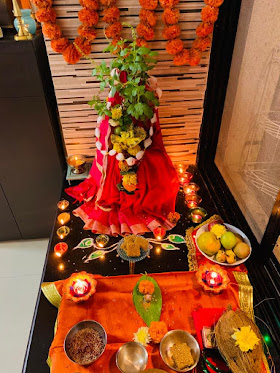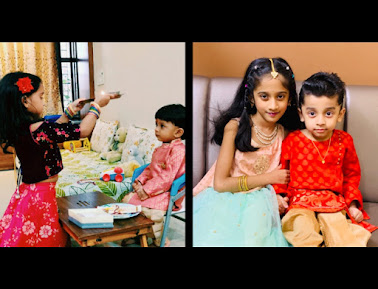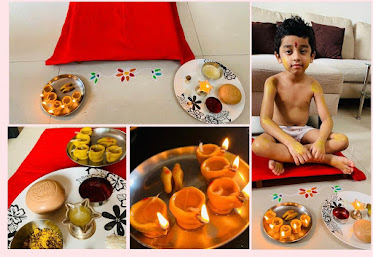Tulsi (Holi Basil) is the most sacred plant in Hinduism. Tulsi Vivah is a Hindu ceremonial marriage of the Tulsi plant (Holy basil) to the Lord Vishnu. It falls on the 11th day (Ekadashi) of Shukla Paksha of the Kartik month. This day is also celebrated as Dev Uthani Ekadashi. It is believed that the person who performs the ritual of Tulsi marriage gets as much virtue as one gets from Kanyadaan.
The ceremonial festival is performed anytime between Prabodhini Ekadashi and Kartik Pornima. Tulsi wedding signifies the end of the monsoon and the beginning of the wedding season in Hinduism. There is a mythological story behind this ritual.
- Kumkum, haldi, chandan
- Flowers
- Prasad (sesame/Til vadi or ladoo)
- Five fruits
- Panchamrut (a mixture of milk, honey/sugar, ghee, gangajal, dahi)
- Antarpat (a white cloth with red swastik - draw it with kumkum)
- Akshata (Jowar grain colored with haldi)
- Two betel leaves (vidyache paan) and supari (as a symbol of Ganesha)
- Amla, tamarind, jujube fruit (ber/bor) (you can get it easily in vegetable market)
- On the day of Tulsi Vivah, Decorate a Tulsi plant like a bride with a saree and ornaments including Mangalsutra, nath (nose ring), toe ring and bangles.
- Build a mandap around Tulsi Vrindavan with a sugarcane pavilion.
- The groom is an idol or a picture of Lord Krishna (Avatar of Lord Vishnu) or the Shaligram stone (the symbol of Lord Vishnu).
- Decorate Tulsi devi with chunari, flowers and garlands before wedding.
- At first, worship Lord Ganesha. Put it in taaman and bathe it with water and panchamrut. clean the idol properly and place it on a chouwky and offer Kumkum, haldi, chandan and flowers.
- Then, put an idol of Lord Krishna in a taaman (a copper/silver plate) and bathe it with water and panchamrut and place it on a chouwky in front of Tulsi vrindavan beside Lord Ganesha.
- Perform puja of Lord Krishna and Tulsi devi by offering Kumkum, haldi, chandan and flowers.
- Hold Antarpat (a white cloth with a red kumkum swastik in the center of it) between Goddess Tulsi (bride) and Lord Krishna (groom).
- Sing five Mangalashtaka (mangal songs or mantras) and in between sprinkle Akshada on bride and groom while singing mangal songs. visit this link for Mangalashtak: Mangalashtaka
- After Mangalashtaka, hold Lord Krishna in both hands and move it around Goddess Tulsi seven times.
- At last, Place Lord Krishna near Goddess Tulsi in Vrindavan and shower flowers on them and say "Bor chinch avala, krishna dev savla"
- Tie a holy thread (cotton thread) between Tulsi and Lord Vishnu’s idol.
- Offer Prasad along with fruits and flowers, and conclude the Puja with Aarti.
 |
| Tulsi vivah pooja perfrom in villages |
 |
| Tulsi theme based Rangolis |






















